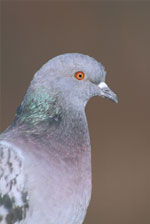Threats
to Birds - Rock Pigeon (Columba livia)
Overview
Rock Doves (also called Rock Pigeon) are common in urban areas and on farms throughout the world. It was first introduced to North America in the early 1600s. It is a native to rocky cliffs of western and southern Europe, North Africa and southwest Asia. Rock Pigeon commonly nests on city buildings and window ledges. The Rock Dove was used for food, entertainment, and as messengers before electronic communication was possible for over 5,000 years. These birds are still bred for racing and are well-known for their strong homing instinct and ability to fly long distances. However, wild Rock Doves rarely leave their location.
Description
Because they have been bred for thousands of years, feral Rock Doves have a great variety of plumages, including light and dark gray, tan, and white. Builds a flimsy nest of straw and sticks on city building ledges, but it often reuses the location, building a new nest on top of the first. Lays 1-3 white eggs. Adults are 11 - 14" long. Eats seeds, fruits, and rarely insects; forages on ground and often in flocks.
Birds Affected
Because it lives in urban and other human-modified areas, the Rock Pigeon probably has not had a significant effect on native bird populations.
Control Locally controlled by poisoning, shooting, trapping; erecting barriers to their roosting such as Nixalite Strips or “porcupine wire,” visual, audible, and sonic devices. |
